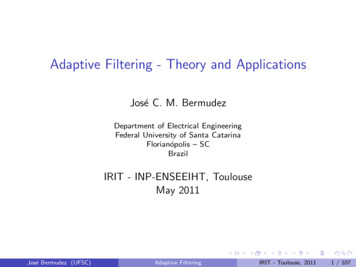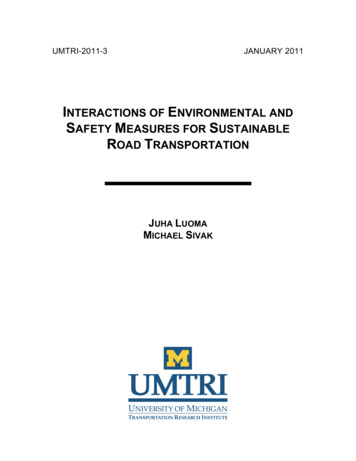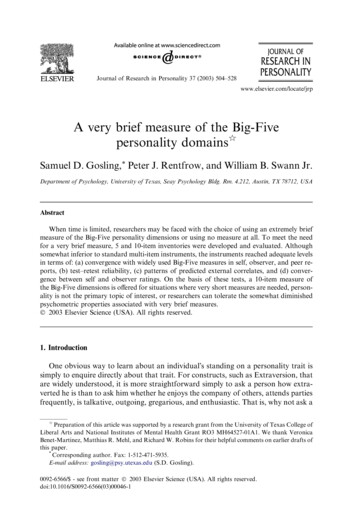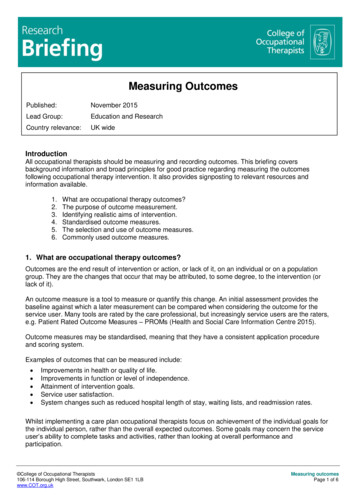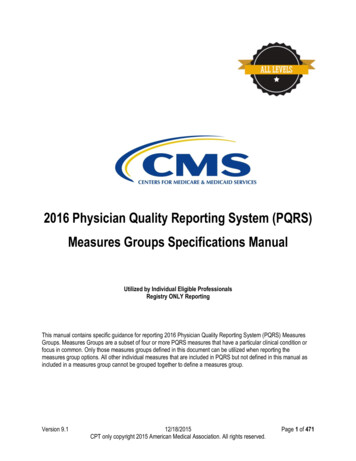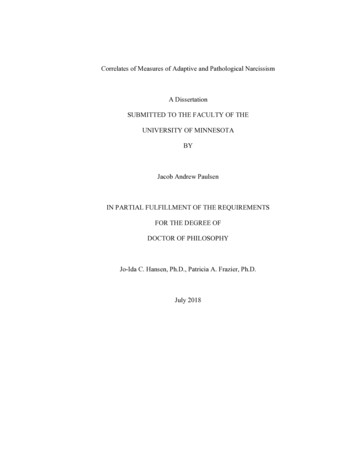
Transcription
Correlates of Measures of Adaptive and Pathological NarcissismA DissertationSUBMITTED TO THE FACULTY OF THEUNIVERSITY OF MINNESOTABYJacob Andrew PaulsenIN PARTIAL FULFILLMENT OF THE REQUIREMENTSFOR THE DEGREE OFDOCTOR OF PHILOSOPHYJo-Ida C. Hansen, Ph.D., Patricia A. Frazier, Ph.D.July 2018
Jacob A. Paulsen, 2018
iAcknowledgementsFirst, I would like to thank my advisors, Jo-Ida C. Hansen, Ph.D., and Patricia A.Frazier, Ph.D., for their years of guidance and mentorship. This impossible dream wouldnever have been realized without their continued support and encouragement. I wouldlike to thank Moin Syed, Ph.D., and Matt Kushner, Ph.D., for their important roles in mytraining as a scientist and a psychologist as well as for serving as members of mydissertation committee. I would like to thank Mark Stellmack, Ph.D., who supervisedmany semesters of my teaching and served as an excellent pedagogical role model. Iwould like to thank Lynn Northrop, Ph.D., and Michael Burke, Psy.D., for their directionand supervision during my doctoral internship. I would like to thank Ann Mullaney,Ph.D., for her friendship and for sharing my obsession and dedication to the study ofLatin Language. My parents, my sister Laura, and my loving wife, Sarah, have remainedardent and steadfast supporters during every step of this long and arduous journey, forwhich I am forever thankful.
iiAbstractSocial scientists have exhibited increased interest in narcissism in recent years and lively debatesand discussion abound about potential narcissism cohort effects and their implications. The mostwidely used measure of narcissism has been the Narcissistic Personality Inventory (NPI), whichhas a history of being considered a measure of adaptive, subclinical trait narcissism. However,increasing evidence suggests that the NPI captures elements of both adaptive and maladaptivenarcissism. In an attempt to better define the nomological network of narcissism and theboundaries between adaptive and maladaptive narcissism, the current studies included multipleself-report measures of many relevant constructs and also included experimental manipulationand behavioral measures. Analyses conducted on data gathered from two universityundergraduate samples (Sample 1, N 227; Sample 2, N 148) provided increasing evidencethat the NPI does indeed measure some maladaptive or pathological aspects of narcissism.Narcissistic Entitlement, Exploitativeness, and Exhibitionism, as captured by the NPI, wereassociated with a multitude of negative, maladaptive outcomes (e.g., elements of psychopathy andpathological narcissism, Machiavellianism, and various forms of aggression). Thus, these studieshave provided increased clarity regarding narcissism’s nomological network, with specialemphasis on maladaptive and pathological elements and associations. The scientific communitycontinues to debate and present competing evidence of possible narcissism cohort effects inrecent decades. The current studies have provided increased clarity with respect to one aspect ofsuch debates; if NPI scores have indeed been increasing across recent decades, this is a cause forsignificant societal concern.Keywords: narcissism, psychopathology, psychopathy, aggression, emerging adulthood
iiiTable of ContentsList of Tables .ivList of Figures vIntroduction 1Study 1 .40Methods .40Results .57Discussion .67Study 2 .78Methods .79Results .88Discussion .92General Discussion . 96References .103Tables .119Figures .127Appendix 133
ivList of TablesTable 1a. Descriptive statistics for Sample 1 Scales as Means (p.119)Table 1b. Descriptive statistics for Sample 2 Scales as Means (p.120)Table 2a. Sample 1 Narcissistic Personality Inventory (NPI) relationships with primarystudy variables (p.121)Table 2b. Sample 2 Narcissistic Personality Inventory (NPI) relationships with primarystudy variables (p.122)Table 3a. Sample 1. Pathological Narcissism Inventory (PNI) relationships with primarystudy variables (p.123)Table 3b. Sample 2. Pathological Narcissism Inventory (PNI) relationships with primarystudy variables. (p.124)Table 4. Relationships between Likability and Writing Quality and primary studyvariables. (p.125)Table 5. Relationships between Point Deduction and primary study variables (p.126)
vList of FiguresFigure 1a. Study 2. Condition 1. (p.127)Figure 1b. Study 2. Condition 2. (p.128)Figure 2a. Sample 1 as inclusion criteria were applied. (p.129)Figure 2b. Sample 2 as inclusion criteria were applied. (p.130)Figure 3a. NPI and PNI replicated positive relationships with main studyvariables. (p.131)Figure 3b. NPI and PNI replicated relationships with main study variables. (p.132)
1“A narcissist is someone better looking than you are.”Gore Vidal, The New York Times, 1981IntroductionMuch Ado About NarcissismWho do we think we are? For millennia philosophers and social scientists haveexamined the nature of the mind, and recent centuries have seen a rise in the study ofself-perception and phenomenology. At present, social scientists are actively researchingego-focused topics such as identity formation and change (e.g., Azmitia et al., 2008;McLean & Pasupathi, 2012; Syed & Azmitia, 2009), self-esteem (Mehdizadeh, 2010;Steinfield et al., 2008), ability self-estimates (Freund & Kasten, 2012; Syzmanowicz &Furnham, 2011; Visser et al., 2008) and self-monitoring (Ickes et al., 2006; Hall et al.,2010). However, in recent years the subject of narcissism seems to have taken centerstage in the popular press, and has been the focus of a steadily growing body of scientificresearch. We live in the age of the selfie (i.e., a digital self-portrait captured via a mobiledevice), with each person acting as a self-promoting public relations assistant in front ofan internet audience. The advent of social media, for many, means presenting the self tothe world in a manner unprecedented in human history. Given these advances intechnology and changes in popular culture, it comes as no surprise that the boundaries ofself-presentation (i.e., the difference between normative and pathological self-focus) hasemerged as a popular point of discussion and inquiry. Indeed, social scientists, massmedia, and the general public have all recently increased focus on the personality variablenarcissism.
2Two popular mass media publications on narcissism of the past decade are thebooks Generation Me (Twenge, 2006) and The Narcissism Epidemic: Living in the Age ofEntitlement (Twenge, 2010). These works are foreboding, full of warnings about theharmful effects of an inflated view of the self. The Narcissism Epidemic warns ofnarcissism as a harbinger of materialism, incivility, antisocial behavior, and relationshiptroubles; the back cover mentions that some of the aims of the book are to help readers“identify narcissism, minimize the forces that sustain and transmit it, and treat it ormanage it where we find it.” Needless to say, these books primarily examine thepotentially harmful effects of narcissism.While some popular press books address the negative effects of narcissism andwarn of the impending societal swell of self-obsession and its concomitant pathologies,others are aimed at self-help for family, friends, partners, and coworkers of narcissists.Several popular books offer advice on how to cope with narcissists: Why is it alwaysabout you: The seven deadly sins of narcissism (Hotchkiss, 2003); The object of myaffection is in my reflection: Coping with narcissists (Lerner, 2008); and Disarming thenarcissist: Surviving and thriving with the self-absorbed (Behary, 2013). Anothercategory of popular press books on narcissism is self-help for those who have sufferedfrom narcissistic abuse or weathered various conflicts with narcissists: Psychopath free(expanded edition): Recovering from emotionally abusive relationships with narcissists,sociopaths, and other toxic people (MacKenzie, 2015); Will I ever be good enough?:Healing the daughters of narcissistic mothers (McBride, 2009); Will I ever be free ofyou?: and How to navigate a high-conflict divorce from a narcissist and heal your family(McBride, 2015). Thus, in approximately the past decade, most popular press books on
3narcissism have been of three varieties: 1) warnings about the negative effects ofnarcissism and its rise in recent cohorts of young people, 2) strategies for dealing with“narcissists”, and 3) self-help for those whose lives have been negatively affected bynarcissists and have suffered narcissistic abuse. Furthermore, much of the narcissismrelated content generated by mainstream news sites seems to echo the content found inmass media book publications (e.g., Caprino, 2015). Few popular press books placesignificant emphasis on narcissism as a healthy, positive, adaptive trait (n.b., Malkin,2015, aims for a relatively balanced treatment of the subject).Mass media and popular culture overwhelmingly view narcissism as a negative,maladaptive personality trait. From these accounts, individuals labeled as highlynarcissistic by friends, family, coworkers, or people in general have the capacity to inflictsevere emotional distress, to manipulate others, and to be generally interpersonallyabusive. Given this information, increases in narcissism in a society would be significantcause for alarm. However, popular culture and mass media treatment of narcissism tendto view it as a unidimensional trait, with high levels being maladaptive and pathological.This pop culture conceptualization of narcissism is quite different fromconceptualizations of narcissism in social science research.This study addresses an important question at the heart of a long-running debateamong social scientists: Would a rise in narcissism be such a bad thing? To investigatethis question, this study examines primarily the more worrisome aspects of narcissism,including its relationships with constructs such as psychopathy, aggression, andMachiavellianism. However, narcissism has also consistently exhibited positiveassociations with constructs like subjective well-being, self-esteem, and negative
4associations with constructs such as anxiety and depression. Thus, further exploring theserelationships and better defining the role of narcissism as a potential protective,preventive, or mitigating factor with respect to negative psychological outcomes such asstress, anxiety, and depression is necessary. First, a review of the literature concerningthe nature of narcissism as a psychological construct will be presented, with special focuson the distinctions between normal, adaptive narcissism and narcissism aspsychopathology. Then the results of two studies will be presented that aim to exploreand better define the construct of narcissism as it relates to both adaptive and maladaptiveaspects of the lives of emerging adults.What is Narcissism?Modern pop culture and popular media cast the personality variable narcissism inparticularly negative terms. This is consistent with multiple historical western culturaltraditions. For example, the Greek tale of Narcissus (Νάρκισσος), whence came ourEnglish term narcissism, describes an individual so self-obsessed that he could not bearto part with the majesty of his own reflection (see Caravaggio, 1597). Some tales ofNarcissus see him die due to unimaginable sorrow, whereas others report that hecommitted suicide; in either case, his tale is a warning of the destructive and toxic natureof self-obsession. The Ancient Greeks referred to this sort of destructive self-obsession ashubris (ὕβρις). Aristotle described hubristic behavior as “the affirmation of one’ssuperiority by disgracing or humiliating another person” (Cohen, 1991, p. 174). Evenbefore the rise of the Greek literary tradition, Homer warned about the dangers to societyposed by individuals with an inflated sense of self who were also prone to anger andhostility (e.g., Achilleus [Ἀχιλλεύς]; Homer, 1990). Likewise, the later Roman concept of
5superbia was used to describe a brand of haughty superiority, wanton self-assertion, andabusive arrogance (Dunkle, 1967). Modern popular conceptualizations of narcissism echothese ancient traditions, primarily seeing narcissism as maladaptive and a threat to theindividual and to society. However, in modern psychology, narcissism in commonlyconceptualized as a multifaceted construct with both adaptive and pathological variants.Normative Versus Pathological NarcissismPerhaps the most foundational point of agreement among modern narcissismtheorists and researchers is this: Whether narcissism is described or conceptualized as atrait, a trait constellation, or a psychological construct, narcissism is thought to exist inboth adaptive and pathological natures, considered to be distinct taxa withdistinguishable, although partially overlapping, phenotypic expressions. The dichotomyof adaptive and maladaptive narcissism can be traced back to the psychoanalyticperspective of Sigmund Freud. Freud (1925) conceived of narcissism as existing in twovarieties, which he termed primary narcissism and secondary narcissism. He describedprimary narcissism as a form of adaptive, normative, positive self-regard and self-focusthat is present to some degree in every mentally healthy human being. Freud describedsecondary narcissism as a maladaptive, pathological form of primary narcissism; Freudconceived of a taxonomic distinction with some potential overlap in phenotype. Thus,although significant advances have been made with respect to the study of narcissismsince Freud, the basic distinction between healthy, adaptive narcissism and pathologicalnarcissism persists, with continued conceptual and empirical support (see Cain et al.,2008, and Pincus & Luckowitsky, 2010, for reviews).
6Important to note, however, is that not all theorists agree with theconceptualization of adaptive and pathological narcissism being distinct dimensions ofpersonality; some theorists propose a continuum model, wherein narcissism is a singledimension and individuals range from normal to pathological (e.g., Paulhus, 1998;Watson, 2005). However, Pincus and Lukowitsky (2010) raised an important point,stating, “We do not believe it is possible to define normal and pathological narcissism asopposite poles of a single continuum because the absence of pathological narcissism isnot equivalent to the presence of normal narcissism Although normal and pathologicalnarcissism may share similar relationships with general models of personality, they tendto exhibit opposite patterns of correlations with measures of well-being andmaladjustment” (p.436). Thus, theory and empirical evidence support theconceptualization of narcissism as having both a normal and pathological nature. Thesetwo types of narcissism are described next.Normative NarcissismNarcissism has been conceptualized as a normative feature of human personalitydevelopment. Theorists such as Kohut (1971, 1977) and Kernberg (1984, 1998) theorizedthat healthy, normal adults have narcissistic needs that assist them in maintaining apositive general sense of self and stable self-esteem. Features of normative narcissisminclude a tendency toward positive evaluations and expectations of the self,competitiveness, confidence, ambition, low avoidance motivation, and extraversion.Individuals exhibiting what can be termed subclinical narcissism (i.e., high narcissismthat does not qualify as psychopathology) tend to be manipulative, self-centered, anddominant (see Sedikides et al., 2004, for a review). When conceptualizing narcissism
7within the Big Five personality traits framework (Costa & McCrae, 1995; Goldberg,1990; John & Srivastava, 1999), Paulhus (2001) reported that narcissism manifested as ahigh level of extraversion and a low level of agreeableness. Further, there is evidence tosuggest that the self-report questionnaire responses and laboratory behaviors of thosescoring higher on narcissism are also borne out in their daily behaviors; they tend toengage in more extroversion-consistent social behaviors and be less interpersonallyagreeable in their daily lives and interactions (Holtzman et al., 2010). Thus, high levels ofnormal, subclinical narcissism appear to manifest as a sort of disagreeable extroversion.Normal narcissism has been found to be negatively associated with anxiety(Watson & Binderman, 1993) and depression (Watson & Binderman, 1993; Wink, 1992),and positively associated with subjective well-being (Rose, 2002) and self-esteem (e.g.,Campbell et al., 2002; Raskin & Terry, 1988; Sedikides et al., 2004). Sedikides et al.reported on a series of five studies showing significant positive linear associationsbetween narcissism and good psychological health, which were found to be mediated byself-esteem. Specifically, self-esteem mediated the relations between narcissism and bothdepression and subjective well-being, and partially mediated the relation betweennarcissism and loneliness. Furthermore, the authors provided evidence that the observedresults were not due to a narcissistic response bias (i.e., presenting the self in an overlyfavorable manner). In sum, Sedikides et al. presented evidence that “the self-esteemcomponent of normal narcissism accounts for the link between normal narcissism andpsychological health. However, self-esteem may not account exclusively for that link” (p.413).
8When taken together, research and theory on normal narcissism paint a picture ofa normal narcissism as containing a combination of the following: confidence,extraversion, interpersonal dominance, competitiveness, ambition, low avoidancemotivation, low agreeableness, and high, stable self-esteem. One begins to form an imageof a person who is upfront, outgoing, perhaps appears arrogant and somewhatinterpersonally abrasive and dominant in conversations, yet maintains a relatively highlevel of subjective well-being and whose personality does not cause them significantimpairment in any of their major life domains (e.g., interpersonal, academic,occupational).Narcissism as PsychopathologyLiterature concerning pathological narcissism can be categorized into three mainbodies: 1) clinical theories and research on psychotherapeutic interventions, 2) theoriesand research from social and personality psychology, and 3) research conducted based ondiagnostic criteria found in the DSM (APA, 2000, 2013) (Cain et al., 2008).Unfortunately, a degree of disconnect between these three areas exists, with no goldstandard definition of the construct, leading to a criterion problem: “thus, whether it isclinically described or empirically measured, it can be difficult to synthesize among andacross clinical observations and empirical findings” (Pincus & Lukowitsky, 2010, p.437).Cain et al. (2008) reviewed phenotypic descriptions of pathological narcissismover approximately 35 years of clinical psychology, social/personality psychology, andpsychiatry literature and collected over 50 labels used to describe behavior. The authorsreported that the various labels were best described by two broad themes, termed
9Grandiosity and Vulnerability. Similarly, a strong base of empirical evidence and a richhistory of theory suggest that pathological narcissism consists of two broad phenotypes,grandiosity and vulnerability (see Cain et al., 2008 and Pincus & Lukowitsky, 2010, formore thorough review).The DSM-5 (APA, 2013) diagnostic criteria for Narcissistic Personality Disorder(NPD) are heavily focused on the grandiose narcissism phenotype. NPD diagnosticcriteria include: grandiose sense of self-importance; preoccupation with fantasies ofunlimited success, power, brilliance, beauty, or ideal love; a belief that one is special andcan only be understood by or associate with other special people or institutions; desire forexcessive admiration; sense of entitlement; lack of empathy; often envious of others orconvinced that others are envious of her or him; and haughty, arrogant behaviors andattitudes.Despite the focus of the DSM-5’s (APA, 2013) diagnostic criteria on the theme ofgrandiosity, according to Pincus and Lukowitsky (2010), “the core feature of pathologicalnarcissism is not grandiosity, but rather defective self-regulation leading to grandiose andvulnerable self and affect states” (p. 436). Although not specifically mentioned in thediagnostic criteria, the DSM-5 does make mention of the vulnerability inherent inpathological expressions of narcissism and the concomitant self-regulatory deficits.Indeed, individuals with NPD are extremely sensitive to negative feedback, criticism, orother ego threats or challenges to their inflated self-image. Individuals with NPD may beunwilling to take risks or to accept feedback, and thus struggle in academic oroccupational settings. The entitlement, need for admiration, and lack of empathy cansignificantly impair the interpersonal and relational functioning of individuals with NPD.
10Additionally, individuals with NPD may react aggressively (overtly or covertly) andimpulsively to criticism, perceived slight, or other ego-threats. NPD is also associatedwith major depressive disorder, dysthymia, anorexia nervosa, and substance use disorders(APA, 2000, 2013).Narcissism as psychopathology is perhaps best summed up with a quote fromPincus and Lukowitsky (2010):All individuals have normal narcissistic needs and motives however,pathologically narcissistic individuals appear particularly troubled when facedwith disappointments and threats to their positive self-image. Since no one isperfect and the world is constantly providing obstacles and challenges to desiredoutcomes, pathological narcissism involves significant regulatory deficits andmaladaptive strategies to cope with disappointments and threats to positive selfimage. (p. 426).Narcissism and Self-EsteemThe relationship between narcissism and self-esteem is quite complex. Primafacie, the research literature on the relationships between narcissism and self-esteemseems to have produced somewhat inconsistent results. However, as research in this areahas progressed, social scientists have put forth models and hypotheses in an attempt toaccount for a body of seemingly disparate findings. A relative consensus exists amongsocial scientists that narcissism and self-esteem are indeed different constructs and thatnarcissism is not simply the high end of a self-esteem spectrum. However, manyquestions remain to be answered about the way that general self-esteem, domains of self-
11esteem, or components of self-esteem relate to different forms of narcissism orcomponents of narcissism.Narcissism is commonly conceptualized as having two natures (normal andpathological), two phenotypes (grandiosity and vulnerability), two modes of expression(overt and covert), and researchers have expressed a range of opinions regarding theconstruct’s structure (category, dimension, prototype) (see Pincus & Lukowitsky, 2010).Likewise, conceptualization regarding self-esteem contains diverse perspectives. Someresearchers distinguish between implicit (automatic, uncontrollable, perhaps unconsciousfeelings toward the self) and explicit (purposeful, controllable, deliberate feelings towardthe self) self-esteem (Bosson et al., 2008), asserting that narcissism reflects a highexplicit self-esteem masking a low implicit self-esteem.The works of Freud (1925), Kohut (1966, 1977), and Kernberg (1975) producedconceptualizations of narcissism that evolved into the Mask Model of self-esteem. TheMask Model of self-esteem posits that those exhibiting pathological narcissism develop afragile, empty, weakened, and under-stimulated sense of self beginning early inchildhood and develop narcissistic grandiosity as a defense strategy, masking underlyingfeelings of inadequacy and inferiority. Such individuals develop overly positive selfviews, which they maintain using a variety of strategies such as overestimating theirabilities, manipulating and devaluing others, and generally viewing themselves assuperior to other people. However, this grandiose outward presentation is thought to be adefensive strategy that can break down in the face of ego threats and result in a variety ofmaladaptive behaviors (e.g., violence, verbal or emotional abuse, substance use) on thepart of the highly narcissistic individual. This fragile grandiose self-image requires
12continued reinforcement. When narcissists are faced with ego threats, they can havetrouble self-regulating, and engage in maladaptive behaviors that result in negativeoutcomes for themselves (e.g., substance abuse) and for those around them (e.g., verbal,emotional, or physical abuse, aggression, and violence). “The Mask Model predicts thatpeople who score high on the Narcissistic Personality Inventory (NPI; Raskin & Terry,1988) should reveal very high levels of explicit self-esteem combined with relatively lowlevels of implicit self-esteem” (Bosson et al., 2008, p. 1418).Tests of the Mask Model by researchers have yielded inconsistent results, leavingthe model with a lack of general support (see Boson et al., 2008). One possible reason forinconsistent results is the relative unreliability of measures of implicit self-esteem(Bosson et al., 2008). Another potential reason for inconsistent findings is that the NPImeasures primarily normal, adaptive narcissism (see Pincus & Lukowitsky, 2010);perhaps significant differences between implicit and explicit self-esteem only arise inthose exhibiting clinical, pathological narcissism, which is not captured by the NPI.Although the Mask Model of self-esteem and narcissism has thus far failed to garnersignificant support, researchers continue to investigate the relationships between differentcomponents or types of narcissism and different aspects of self-esteem.Brown and Zeigler-Hill (2004) reported that the correlations between theRosenberg Self-Esteem Scale (RSES; Rosenberg, 1965) and the NPI ranged between r .09 and r .41, with a mean of r .26. The authors described these results as contrary toexpectations, given that narcissists are arrogant and self-inflating. Yet, the RSES aims tocapture the degree to which a person felt approximately equal in worth to others, not the
13degree of superiority felt toward others (Rosenberg, 1965). Given that, the somewhat lowcorrelations between the NPI and the RSES make sense.Indeed, one difficulty in integrating the literature on self-esteem and narcissism isthat different measures of self-esteem seem to measure different things. Various measuresof self-esteem differ in whether they ask participants their perceptions of themselves asbeing 1) as good as most other people, 2) not inferior to other people, or 3) better thanother people (Brown & Zeigler-Hill, 2004). Brown and Zeigler-Hill hypothesized thatnarcissism would be more strongly related to measures of self-esteem that contain atheme of dominance (e.g., that one is somehow special or superior to others) thanmeasures not focused on dominance but rather parity with others, such as the RSES (e.g.,that one is of equal worth to other people). The authors included multiple measures ofself-esteem, the NPI, as well as a measure of dominance in their study. Indeed, the NPIwas more highly correlated with measures of self-esteem that were themselves morehighly correlated with dominance. Furthermore, when controlling for dominance, thecorrelations between the NPI and each self-esteem measure were significantly reduced.Brown and Zeigler-Hill’s “dominance hypothesis” added significantly to theunderstanding of why self-esteem has exhibited differential relationships with narcissismthroughout the body of research literature. According to this hypothesis, measures of selfesteem that capture a sense of dominance or superiority (as opposed to parity with others)are more likely to exhibit stronger correlations with measures of narcissism. Measures ofself-esteem that also capture a sense of dominance - of being “superior” to others asopposed to “of equal worth” - are likely capturing some of the grandiosity that iscommonly associated with narcissism; this has potential to create a sort of tautology in
14which researchers are essentially correlating narcissism with narcissism instead ofcorrelating general self-esteem with narcissism. The RSES items assess the degree towhich the respondent feels that she or he is of equal worth to others, as opposed toassessing a sense of superiority to others. Thus, using a measure of self-esteem lesscorrelated with the theme of dominance should produce data in which narcissism andhealthy self-esteem are less confounded.Tracy and Cheng (2009) advanced a model for helping distinguish betweennarcissistic self-aggrandizement and genuine high self-esteem. Although they are bothforms of self-favorability, narcissism and self-esteem are thought to be fueled bycombinations of different emotions - shame and two facets of pride, authentic andhubristic. Shame is conceptualized as self-scrutiny and negative self-evaluation in theface of negative events, resulting in feelings of worthlessness and powerlessness(Gramzow & Tangney, 1992). “Authentic pride is the more socially desirable,achievement-oriented facet, associated with accomplishment and confidence. Hubristicpride is the more narcissistic facet, associated with arrogance and conceit” (p.197). Tracyet al. provided evidence that narcissistic self-aggrandizement and genuine self-esteem aredistinct constructs. Authentic pride exhibited a positive linear relationship with genuineself-esteem. Hubristic pride exhibited a positive linear relationship with narcissism (asmeasured with the NPI, NPD diagnosis, or overestimation of the degree of socia
"A narcissist is someone better looking than you are." Gore Vidal, The New York Times, 1981 Introduction Much Ado About Narcissism . 2008); and Disarming the narcissist: Surviving and thriving with the self-absorbed (Behary, 2013). Another category of popular press books on narcissism is self-help for those who have suffered


